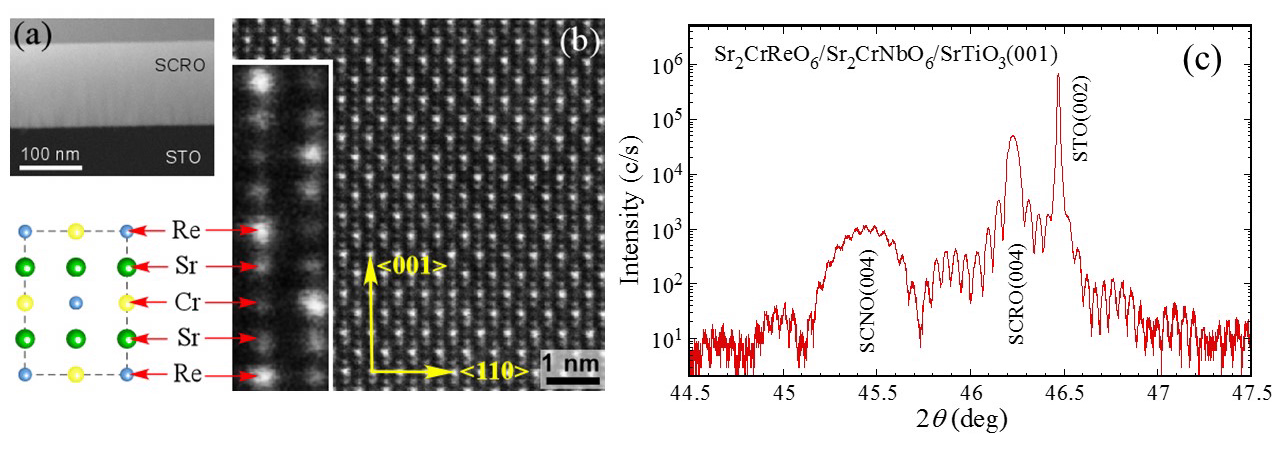The A2BB’O6 double perovskites (DP) exhibit a variety of attractive phenomena, including rich magnetic interactions such as ferrimagnetism with high spin polarization and Curie temperatures (TC) well above room temperature, both characteristics needed for practical spintronic applications.
Supported by the Center for Emergent Materials (CEM), a National Science Foundation (NSF) Materials Research Science and Engineering Center (MRSEC) at Ohio State, we developed a novel off-axis ultrahigh vacuum sputtering technique for epitaxial film deposition of highly ordered double perovskites, which has led to growth of state-of-the-art quality epitaxial films of a variety of complex materials, including double perovskites, Heusler compounds, Yttrium Iron Garnet (YIG), iridate pyrochlore oxides, and spinel oxides.

(a), (b) STEM images of a Sr2CrReO6 (001) film on SrTiO3, (c) XRD scan of a SCRO film on a SCNO buffer layer on STO.
We observed clear B/B’ sites double perovskite ordering in Sr2FeMoO6 and Sr2CrReO6 films as shown by both Scanning Transmission Electron Microscopy (STEM) and x-ray diffraction (XRD). Using epitaxial strain, we demonstrated the capability in tuning magnetocrystalline anisotropy in Sr2FeMoO6 films with a striking, linear dependence of the out-of-plane anisotropy on the strain-induced tetragonal distortion. This anisotropy can be tuned in a range sufficient to rotate the easy axis from in-plane to out-of-plane. The fully ordered Sr2CrReO6 films exhibit a saturation magnetization of 1.29 µB/f.u., confirming the presence of strong spin-orbit coupling. Surprisingly, we discovered that Sr2CrReO6 is actually a semiconductor, not a half metal as previously believed. By growing Sr2CrReO6 films on Sr2CrNbO6 buffer layers, we demonstrate significant improvement of the Cr/Re ordering and minimized defect states near the interface.
References:
- A. J. Hauser, J. M. Lucy, M. W. Gaultois, M. R. Ball, J. R. Soliz, Y. S. Choi, O. D. Restrepo, W. Windl, J. W. Freeland, D. Haskel, P. M. Woodward, and F. Y. Yang, “Magnetic structure in epitaxially strained Sr2CrReO6 thin films by element-specific XAS and XMCD,” Phys. Rev. B Rapid Communications 89, 180402(R) (2014).
- J. M. Lucy, A. J. Hauser, H. L. Wang, J. R. Soliz, M. Dixit, R. E. A. Williams, A. Holcombe, P. Morris, H. L. Fraser, D. W. McComb, P. M. Woodward, and F. Y. Yang, “Buffer-layer enhanced structural and electronic quality in ferrimagnetic Sr2CrReO6 epitaxial films,” Appl. Phys. Lett. 103, 042414 (2013).
- C. H. Du, R. Adur, H. L. Wang, A. J. Hauser, F. Y. Yang, and P. C. Hammel, “Control of Magnetocrystalline Anisotropy by Epitaxial Strain in Double Perovskite Sr2FeMoO6 Films,” Phys. Rev. Lett. 110, 147204 (2013).
- A. J. Hauser, J. M. Lucy, H. L. Wang, J. R. Soliz, A. Holcomb, P. Morris, P. M. Woodward, and F. Y. Yang, “Electronic and magnetic tunability of Sr2CrReO6 films by growth-mediated oxygen modulation,” Appl. Phys. Lett. 102, 032403 (2013).
- A. J. Hauser, J. R. Soliz, M. Dixit, R. E. A. Williams, M. A. Susner, B. Peters, L. M. Mier, T. L. Gustafson, M. D. Sumption, H. L. Fraser, P. M. Woodward and F. Y. Yang, “Fully Ordered Sr2CrReO6 Epitaxial Films: A High Temperature Ferrimagnetic Semiconductor,” Phys. Rev. B 85, 161201(R) (2012).
- A. J. Hauser, R. E. A. Williams, R. A. Ricciardo, A. Genc, M. Dixit, J. M. Lucy, P. M. Woodward, H. L. Fraser, and F. Y. Yang, “Unlocking the potential of half-metallic Sr2FeMoO6 films through controlled stoichiometry and double-perovskite ordering,” Phys. Rev. B 83, 014407 (2011).